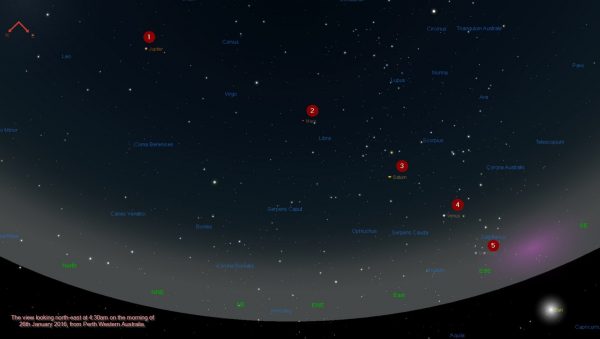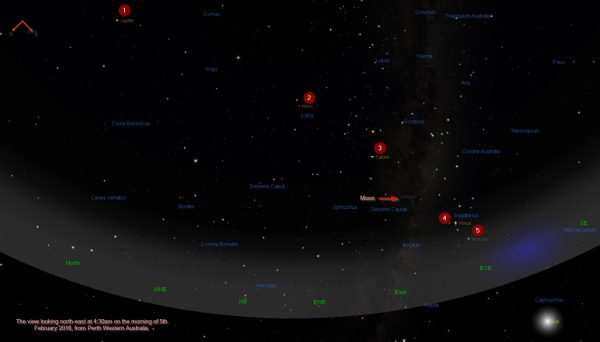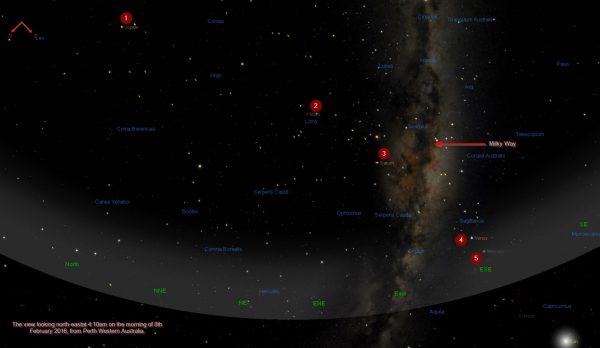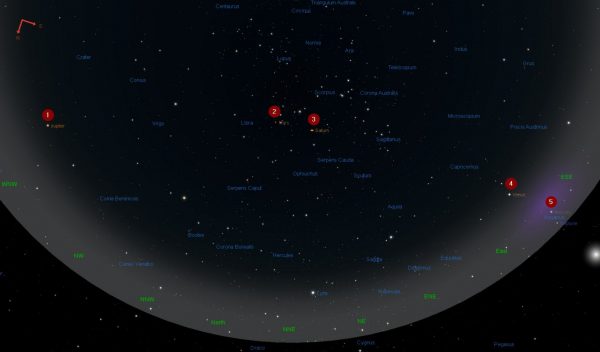The Planets Align in 2016
If you have been to one of our viewing nights at the Perth Observatory this season you might have noticed the absence of planets in the night sky. No Jupiter, Saturn, Mars or Venus to gaze at. So where have they been? Well, in the early morning sky, there to surprise you if you venture out of bed early in the morning.
Over about the next month, the planets of Jupiter, Saturn, Mars, Venus and Mercury are performing a spectacular (all-be-it slow) dance across the early morning eastern sky. So slow in fact that it practically continues from now (late January) until late March when Mercury and Venus will begin to dip below the horizon or very close to it at sunrise. So how does it unfold? Let’s take a look.
Starting on the 26th January (why not start on Australia Day?) we have Jupiter high in the north followed by Mars in the NE, then Saturn in the east then Venus and Mercury lower in the south-east. At this time the Moon will also be taking part, over in the north-west and very bright and full. Being so bright the Moon is going to wash out much of the rest of the sky, but you will still see the planets and bright stars. Here’s an example of the eastern view:

Moving forward the planets will shuffle their position and Mercury continue to rise from the horizon until the 5th February. On the 5th and 6th, February Mercury will be about 10 degrees above the east-southeast horizon, as high as far as it will get from the Sun on this occasion. The other planets will have moved slightly, and Mercury will be much closer to Venus. The Moon will have moved significantly across the sky and away from full to a very much less bright waning 16% illumination, and now be beautifully positioned among the planets between Saturn and Venus. This is how it will look:

The next notable change will come a few days later when the Moon is removed from the equation. At this time the planets will stand out more with the darker sky background and the other stars of the night sky will be allowed to shine brightly. The Milky Way (Scorpius & Sagittarius central region) will be rising beautifully in the eastern sky behind the planets. It’s worth getting up a little earlier now, as the sky will be darker and the Moon not impacting the darkness. The below is shown for 4:10 am on the 8th February:

From this point forward the planets start to separate out a little and Mercury move closer to the sun (below the horizon). There are still good opportunities to view the planets for months to come, but the line up will disperse. Perhaps the last good opportunity for seeing this alignment will be in March, around the 10th March, later in the morning at 5:10 am when Jupiter will be far in the west, Mars and Saturn almost overhead in the north, Venus low in the east and Mercury just barely above the horizon in the east-south-east. Here is the view at 5:10 am on 10th March 2016:

So, there is a whole month and a half in which you can take the opportunity to see this wonderful sight in the early morning night sky – make the most of it and ensure you set your alarm for at least one early rise. Even if you can’t make one of the dates above, the planets will move slowly throughout the month and anytime from now until mid-March will let you see a nice collection of these celestial wanderers.
When viewing this alignment of planets you need nothing more than your eyes. A telescope or binoculars will show you details such as bands on Jupiter, rings of Saturn, polar ice caps on Mars, and such, but to view the spectacle of these planets aligned, you want your eyes simply gazing upwards.
If you wish to photograph the early morning planets an easy way to start is your digital camera on a tripod with a wide-angle lens, fast aperture (f/4 or faster), fast ISO (1600 or faster) and an exposure time of 5-10 seconds. Try using a cable release to minimise camera shake.
During this time we at the Perth Observatory will be continuing with our night sky tours, and from about mid-February onwards will be able to view Jupiter along with its bands and Galilean moons. So, come along to get them up close and personal view of this beautiful planet.





